Kenneth C. Davis's Blog, page 61
January 1, 2017
“2016 Nerdy Book Club Award for Long Form Nonfiction”
In the Shadow of Liberty has been selected for a “2016 Nerdy Book Club Award for Nonfiction”
The citation reads:
“Told through the stories of five people: Billy Lee, Ona Judge, Isaac Granger, Paul Jennings, and Alfred Jackson enslaved to four American presidents: Washington, Jefferson, Madison, and Jackson, this intriguing and highly-readable book presents a chronological account of the early years of American history and the ethical hypocrisy of our Founding Fathers’ beliefs in freedom and self-determination while denying these fundamental rights to so many. Rich with primary source material including personal accounts, this book is a vital addition to text sets and units of study needing underrepresented perspectives.”
Source: 2016 Nerdies: Long Form Nonfiction

December 30, 2016
In the Shadow of Liberty- A Finalist for Yalsa’s Excellence in Nonfiction Award
IN THE SHADOW OF LIBERTY: THE HIDDEN HISTORY OF SLAVERY, FOUR PRESIDENTS, AND FIVE BLACK LIVES has been selected as a finalist for the 2017 Award for Excellence in Young Adult Nonfiction by YALSA –the Young Adult Library Service Association of the American Library Association.
YALSA’s Award for Excellence in Nonfiction honors the best nonfiction book published for young adults (ages 12-18) during a Nov. 1 – Oct. 31 publishing year.
The nomination reads:
In the Shadow of Liberty: The Hidden History of Slavery, Four Presidents, and Five Black Lives by Kenneth C. Davis, and published by Henry Holt, an imprint of Macmillan Children’s Publishing Group
“In a clear-eyed, well-researched work, Davis looks at the relationship between five enslaved persons and the former presidents who considered them property. In weaving together the story of these lives, Davis explains the contradiction between America’s founding ideals and the harsh reality of human bondage. Utilizing personal narratives, census data, images, and other primary source material, this book explains a heartbreaking chapter in American history that is both fascinating and deeply disturbing.”

December 28, 2016
Pop Quiz: Who was the last president born in a slaveholding household?
(Original post revised from 11/2015)

Woodrow Wilson Birthplace, Staunton, VA (Photo: Kenneth C. Davis 2010)
The last president to be raised in a slaveholding household, Woodrow Wilson was born at the manse, or Presbyterian minister’s residence, in Staunton, Virginia on December 28, 1856.
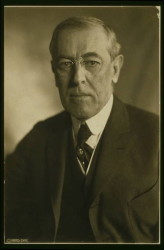
Woodrow Wilson , 1919 (Source: Library of Congress Prints and Photographs digital ID cph.3f06247.)
Thomas Woodrow Wilson grew up in the Deep South during the Civil War as his father moved the family to Georgia and South Carolina. (He later dropped the first name.) A secessionist, his father organized the Presbyterian Church of the Confederate States, and Wilson recalled seeing Robert E. Lee as wounded Confederate soldiers were brought to his father’s church.
At twenty- six, Wilson earned his Ph.D. in political science from Johns Hopkins and began writing scholarly works about government and history— including a five- volume History of the American People, completed after he joined the Princeton faculty. In 1902, he was named president of Princeton.
With the backing of powerful Democrats, he ran for governor of New Jersey and won easily in 1911. He then ran for president and, when former President Theodore Roosevelt announced his third-party run in 1912, Wilson was all but assured of victory.
Initially reluctant to go to war in Europe, he led the nation into World War I. Wilson was awarded the 1920 Nobel Peace Prize, largely for his efforts to organize the League of Nations which the U.S. Senate rejected.
Generally viewed as a progressive Democrat who tried mightily to keep the nation out of war but was eventually forced into it, Wilson has consistently been ranked among America’s top ten presidents. But like any admired or successful president, he did not have a blotless record. Despite many impressive accomplishments, Wilson had flaws and shortcomings that remain troubling. In one recent assessment, biographer John Milton Cooper, Jr., fairly summed them up:
“Two things will always mar his place in history: race and civil liberties. He turned a stone face and deaf ear to the struggle and tribulations of African Americans. . . . During the war, Wilson presided over an administration that committed egregious violations of civil liberties. . . . It remains a mystery why such a farseeing, thoughtful person as Wilson would let any of that occur.”
—John Milton Cooper, Woodrow Wilson (p.11)
The first answer is his upbringing. Although not a fire-breathing white supremacist, he was a product of his birth into a slaveholding house hold with Confederate loyalty. His heritage, and the times, played a role. The second is politics. Keeping a Democratic Southern Congress quiescent required Wilson— and many of his successors in the White House— to tread lightly on matters of race.
Adapted from DON’T KNOW MUCH ABOUT THE AMERICAN PRESIDENTS. Read more about Wilson and his presidency.
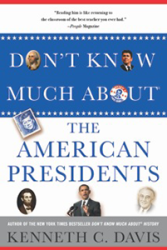
Don’t Know Much About® the American Presidents (Hyperion paperback-April 15, 2014)
Read more about Woodrow Wilson at the Library of Congress.
December 19, 2016
On this Date: “The Crisis, No. 1”
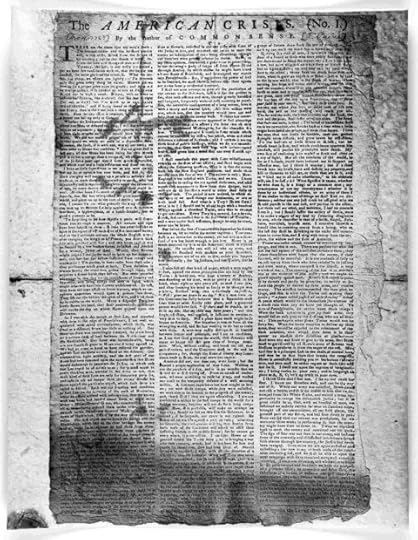 Thomas Paine, The American Crisis (No. 1) (December 1776)
Thomas Paine, The American Crisis (No. 1) (December 1776)
It was the darkest hour in the American revolution.
When Fort Lee in New Jersey fell to the British on November 20, 1776, the Continental Army led by George Washington was forced to retreat into Pennsylvania after a series of crushing defeats. The rebellion was on the verge of collapse.
The same man who had anonymously published Common Sense wrote a clarion call to service in the patriot cause. First in a series of pamphlets, Thomas Paine’s The American Crisis (No. 1) was published on December 19, 1776 and Washington had it read to his demoralized troops.
THESE are the times that try men’s souls: The summer soldier and the sunshine patriot will, in this crisis, shrink from the service of his country but he that stands it NOW, deserves the love and thanks of man and woman. Tyranny, like hell, is not easily conquered; yet we have this consolation with us, that the harder the conflict, the more glorious the triumph. What we obtain, too cheap, we esteem too lightly….
It matters not where you live, or what rank of life you hold, the evil or the blessing will reach you all. The far and the near, the home counties and the back, the rich and the poor, shall suffer or rejoice alike. The heart that feels not now, is dead: The blood of his children shall curse his cowardice, who shrinks back at a time when a little might have saved the whole, and made them happy. I love the man that can smile in trouble, that can gather strength from distress, and grow brave by reflection. ‘Tis the business of little minds to shrink; but he whose heart is firm, and whose conscience approves his conduct, will pursue his principles unto death.
Source and Complete Text: Library of Congress “Thomas Paine Writes ‘The American Crisis'”
Important words to remember. America has survived many great crises. But it has required courage and persistence. “Tyranny, like hell, is not easily conquered.”
December 18, 2016
Who Started the “War on Christmas?”
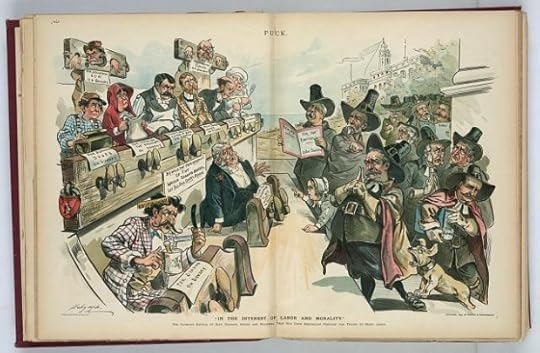
“In the interest of labor and morality” (1895: Image Courtesy of Library of Congress Prints and Photographs Division Washington, D.C. 20540 USA http://hdl.loc.gov/loc.pnp/pp.print)
(Revision of post first published 12.11.2103)
It’s that time of year. Cue the lights, decorations, music.… and the “War on Christmas.”
Proclaiming a secular assault on the religious significance of the holiday has become a seasonal staple, just like the Macy’s Parade with Santa Claus. The President Elect made saying “Merry Christmas” a campaign issue and it has been a staple of conservative talk show hosts for years.
The basic premise: Christmas is under attack by Grinchy atheists and secular humanists who want to remove any vestige of Christianity from the public space. Any criticism of public displays devoted to religious symbols –mangers, crosses, stars — is seen by these folks as part of a wider attack on “Christian values” in America. Mass market retailers who substituted “Happy Holidays” for “Merry Christmas” are part of the conspiracy to “ruin Christmas.”
But in fact, most religious displays are not banned. Courts simply direct that one religion cannot be favored over another under the Constitutional protections of the First Amendment. Christmas displays are generally permitted as long as menorahs, Kwanzaa displays, and other seasonal symbols are also allowed.
In other words, the “War on Christmas” is pretty much a phony war. But where did this all start?
The first laws against Christmas celebrations and festivities in America came during the 1600s –from the same wonderful folks who brought you the Salem Witch Trials — the Puritans. (By the way, H.L. Mencken once defined Puritanism as the fear that “somewhere someone may be happy.”)
“For preventing disorders, arising in several places within this jurisdiction by reason of some still observing such festivals as were superstitiously kept in other communities, to the great dishonor of God and offense of others: it is therefore ordered by this court and the authority thereof that whosoever shall be found observing any such day as Christmas or the like, either by forbearing of labor, feasting, or any other way, upon any such account as aforesaid, every such person so offending shall pay for every such offence five shilling as a fine to the county.”
–From the records of the General Court,
Massachusetts Bay Colony
May 11, 1659
The Founding Fathers of the Massachusetts Bay Colony were not a festive bunch. To them, Christmas was a debauched, wasteful festival that threatened their core religious beliefs. They understood that most of the trappings of Christmas –like holly and mistletoe– were vestiges of ancient pagan rituals. More importantly, they thought Christmas — the mass of Christ– was too “popish,” by which they meant Roman Catholic. These are the people who banned Catholic priests from Boston under penalty of death.
This sensibility actually began over the way in which Christmas was celebrated in England. Oliver Cromwell, a strict Puritan who took over England in 1645, believed it was his mission to cleanse the country of the sort of seasonal moral decay that Protestant writer Philip Stubbes described in the 1500s:
‘More mischief is that time committed than in all the year besides … What dicing and carding, what eating and drinking, what banqueting and feasting is then used … to the great dishonour of God and the impoverishing of the realm.’
In 1644, Parliament banned Christmas celebrations. Attending mass was forbidden. Under Cromwell’s Commonwealth, mince pies, holly and other popular customs fell victim to the Puritan mission to remove all merrymaking during the Christmas period. To Puritans, the celebration of the Lord’s birth should be day of fasting and prayer.
In England, the Puritan War on Christmas lasted until 1660. In Massachusetts, the ban remained in place until 1687.
So if the conservative broadcasters and religious folk really want a traditional, American Christian Christmas, the solution is simple — don’t have any fun.
Read more about the Puritans in Don’t Know Much About® History and America’s Hidden History. The history behind Christmas is also told in Don’t Know Much About® The Bible.
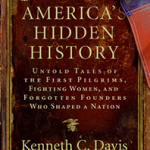
America’s Hidden History, includes tales of “Forgotten Founders”

Don’t Know Much About History (Revised, Expanded and Updated Edition)

Who Said It (12.18.2016)
Virginia Statute for Religious Freedom (enacted in 1786)

Thomas Jefferson. “An Act for Establishing Religious Freedom,” 16 January 1786. Manuscript. Records of the General Assembly, Enrolled Bills, Record Group 78. Lab# 07_0071_01. Image courtesy the Library of Virginia
“No man shall be compelled to frequent or support any religious worship, place, or ministry whatsoever, nor shall be enforced, restrained, molested, or burthened (sic) in his body or goods, nor shall otherwise suffer on account of his religious opinions or belief …”
The original language of this legislation was drafted by Thomas Jefferson in 1776. His draft is lost. Here is the full text go the act as passed from Monticello.
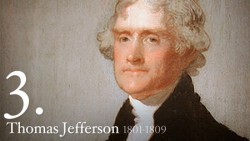
Thomas Jefferson, third president (Source: White House)
James Madison later revised the bill, and under his direction, it became part of Virginia law in 1786 — a year before the U.S. Constitution was drafted.
Madison later called upon these ideas to draft what became the 1st Amendment to the Constitution.

John Adams, Second POTUS , official portrit (Source White House Historical Association)
Jefferson considered this law, along with writing the Declaration of Independence and founding the University of Virginia as his three most significant accomplishments , the three achievements engraved on his tombstone.
Read more about the Virginia Statute for Religious Freedom at Learning Resources from Monticello.
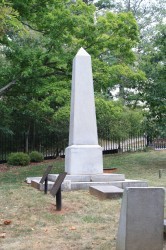
Thomas Jefferson’s Grave Marker at Monticello
December 9, 2016
Who Said It? (12/9/2016)
George Washington, Last Will and Testament (dated July 9, 1799). George Washington died on December 14, 1799.
And to my Mulatto man William (calling himself William Lee) I give immediate freedom; or if he should prefer it (on account of the accidents which hae befallen him, and which have rendered him incapable of walking or of any active employment) to remain in the situation he now is, it shall be optional in him to do so: In either case however, I allow him an annuity of thirty dollars during his natural life, whic shall be independent of the victuals and cloaths he has been accustomed to receive, if he chuses the last alternative; but in full, with his freedom, if he prefers the first; & this I give him as a testony of my sense of his attachment to me, and for his faithful services during the Revolutionary War.

Portrait of George Washington, Gilbert Stuart
William Lee was purchased by George Washington from a neighbor in October 1767. “Billy” Lee served Washington as personal attendant for decades, including every day of the Revolution. He attended Washington in Philadelphia in 1787 when the Constitution was debated and went to New York in 1789 to serve the first President. Practically crippled after a series of accidents, Lee was forced to return to Mount Vernon where he lived out his days.
“George Washington prepared his will alone, without, as he attested, any ‘professional character’ being ‘consulted’ or having ‘any Agency in the draught.’ He dated the will, the work of many ‘leisure hours,’ the ‘ninth day of July’ in 1799, probably the date that he finished making the final copy….His executors presented the new will for probate within a month, on 10 January 1800, to the Fairfax County Court, in whose custody it remains. A few days thereafter the will was printed in Alexandria. It then circulated throughout the country in pamphlet form.”
William Lee was the only person enslaved by Washington who was emancipated immediately upon Washington’s death, as the will stipulated. He remained at Mount Vernon until his death, the date of which is not known. His remains are presumed to be buried in the African American burial ground at Mount Vernon.
The complete story of William Lee and his relationship with Washington is told in my recent book, In the Shadow of Liberty: The Hidden History of Slavery, Four Presidents, and Five Black Lives.
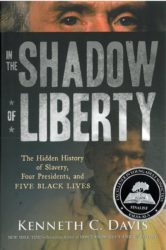
December 8, 2016
In the Shadow of Liberty- A Finalist for 2017 Award for Excellence in Young Adult Nonfiction
IN THE SHADOW OF LIBERTY: THE HIDDEN HISTORY OF SLAVERY, FOUR PRESIDENTS, AND FIVE BLACK LIVES has been selected as a finalist for the 2017 Award for Excellence in Young Adult Nonfiction by YALSA –the Young Adult Library Service Association of the American Library Association.
YALSA’s Award for Excellence in Nonfiction honors the best nonfiction book published for young adults (ages 12-18) during a Nov. 1 – Oct. 31 publishing year.
The nomination reads:
In the Shadow of Liberty: The Hidden History of Slavery, Four Presidents, and Five Black Lives by Kenneth C. Davis, and published by Henry Holt, an imprint of Macmillan Children’s Publishing Group
“In a clear-eyed, well-researched work, Davis looks at the relationship between five enslaved persons and the former presidents who considered them property. In weaving together the story of these lives, Davis explains the contradiction between America’s founding ideals and the harsh reality of human bondage. Utilizing personal narratives, census data, images, and other primary source material, this book explains a heartbreaking chapter in American history that is both fascinating and deeply disturbing.”

December 5, 2016
Don’t Know Much About® Van Buren

President Martin Van Buren (Photo Courtesy of Library of Congress Prints and Photographs Division)
(Post updated 12/5/2016)
OK –Literally.
Martin Van Buren, the eighth President of the United States, was born on December 5, 1782 in Kinderhook, New York, making him the first American president born a U.S. citizen. Van Buren was also known as “Old Kinderhook, or “OK,” the origin of that American expression.
Van Buren was also the first New Yorker elected President. He was a crafty political power broker who mastered the art of “machine politics” and helped bring New York into Andrew Jackson’s column in 1828. He became Jackson’s Secretary of State and later his vice president. He won the presidential election of 1836. But his presidency was tainted by the Panic of 1837, a deep economic depression that lasted seven years. He was defeated in 1840 by William Henry Harrison of the Whig Party.
Fast Facts:
•Van Buren was the first president not of English descent. Growing up in a Dutch-speaking household, he was also the only president who spoke English as a second language.
•As a young attorney, he became the protege of Aaron Burr. Due to a passing resemblance and their political and professional connections, it was rumored that he was Burr’s son, gossip thoroughly dismissed by historians.
•Elected Governor of New York in November 1828, Van Buren took the office on January 1, 1829 but resigned on March 12, 1829 to become secretary of state, making him the shortest tenured governor in New York history.
•During Van Buren’s administration, the removal of native Americans from the Southeast accelerated including the removal of the Cherokee on the “Trail of Tears.”
•The Congressional “gag rule” was passed during his presidency; the rule forbid any discussion of petitions relating to slavery, including banning slavery in Washington, D.C, as mentioned in Van Buren’s inaugural address above.
•Failing to win the Democratic nomination in 1844, Van Buren became the first president to run on a third party ticket when he joined the Free Soil Party as its candidate in 1848.
You can read more about his life at the Martin Van Buren Historical Site (National Parks Service) and at the Library of Congress.
And read more about Van Buren and his administration in Don’t Know Much About® the American Presidents

Don’t Know Much About® the American Presidents (Hyperion Paperback-April 15, 2014)
November 22, 2016
Two for Thanksgiving: Real First Pilgrims & Holiday’s History
Like the Macy’s parade, here is my Thanksgiving tradition. I post two articles about the holiday that I wrote for the New York Times.
The first, from 2008, is called “A French Connection” and tells the story of the real first Pilgrims in America. They were French. In Florida. Fifty years before the Mayflower sailed. It did not end with a happy meal. In fact, it ended in a religious massacre.
TO commemorate the arrival of the first pilgrims to America’s shores, a June date would be far more appropriate, accompanied perhaps by coq au vin and a nice Bordeaux. After all, the first European arrivals seeking religious freedom in the “New World” were French. And they beat their English counterparts by 50 years. That French settlers bested the Mayflower Pilgrims may surprise Americans raised on our foundational myth, but the record is clear.
The complete story can be found in America’s Hidden History.
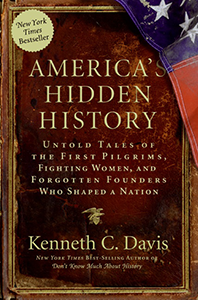
America’s Hidden History, includes tales of “Forgotten Founders”
The second is “How the Civil War Created Thanksgiving” (2014) and tells the story of the Union League providing Thanksgiving dinners to Union troops.
Of all the bedtime-story versions of American history we teach, the tidy Thanksgiving pageant may be the one stuffed with the heaviest serving of myth. This iconic tale is the main course in our nation’s foundation legend, complete with cardboard cutouts of bow-carrying Native American cherubs and pint-size Pilgrims in black hats with buckles. And legend it largely is.
In fact, what had been a New England seasonal holiday became more of a “national” celebration only during the Civil War, with Lincoln’s proclamation calling for “a day of thanksgiving” in 1863.
Enjoy them both. Now for some football.
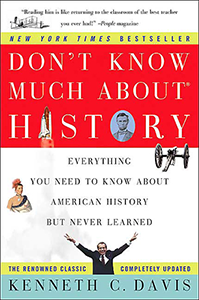
Don’t Know Much About® History: Anniversary Edition (Harper Perennial and Random House Audio)

Don’t Know Much About the Civil War (Harper paperback, Random House Audio)
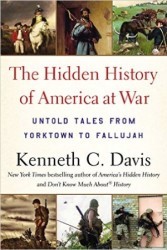
Now In paperback THE HIDDEN HISTORY OF AMERICA AT WAR: Untold Tales from Yorktown to Fallujah



